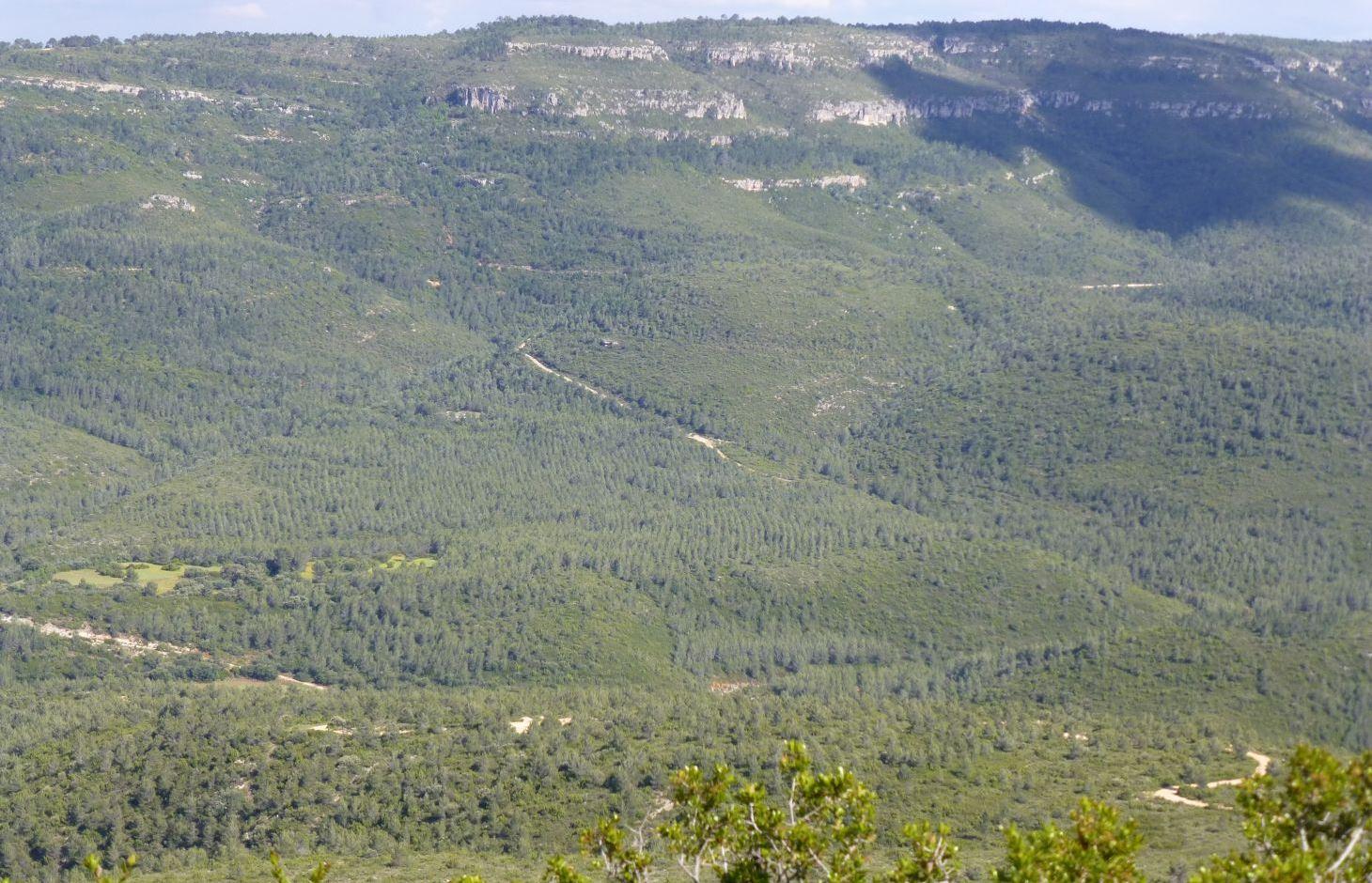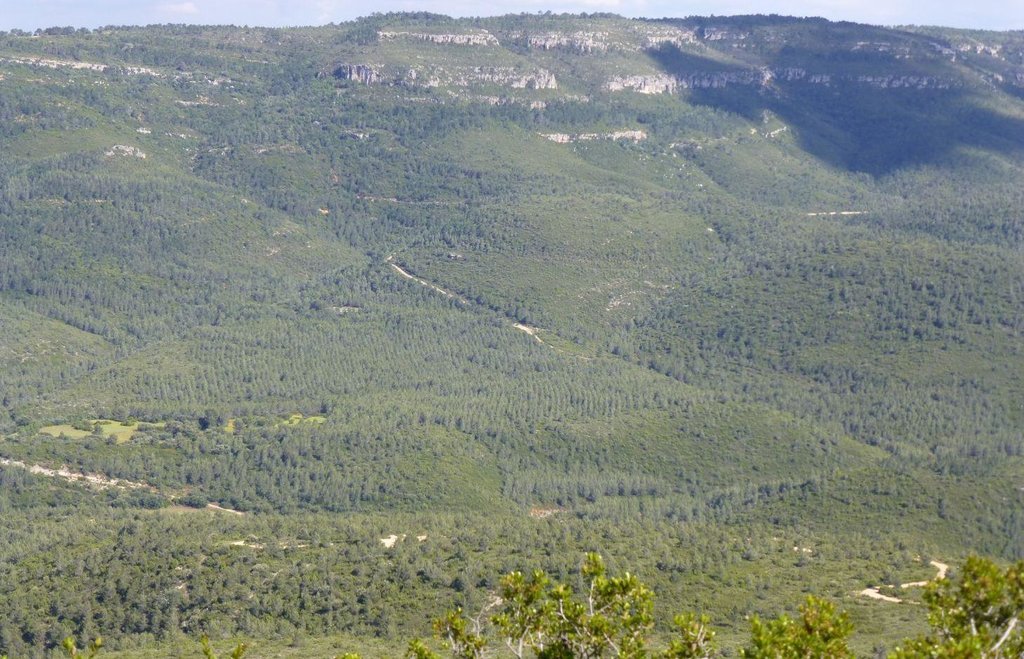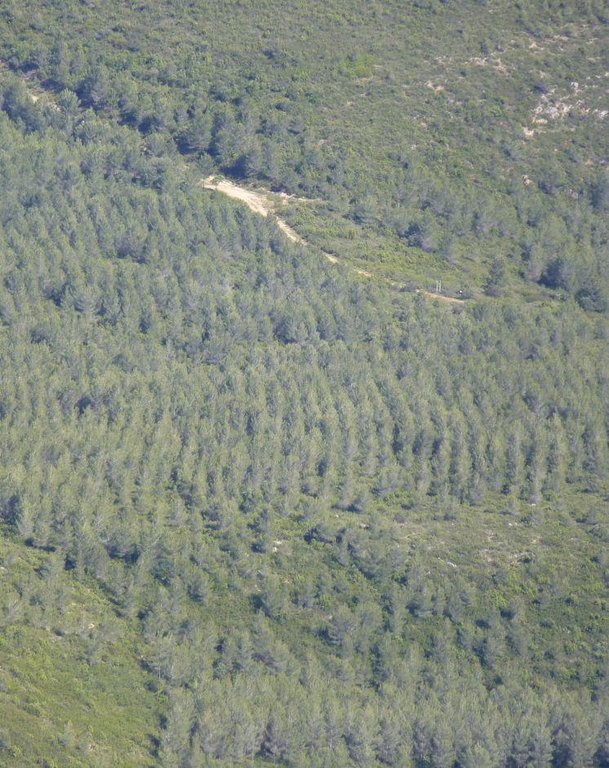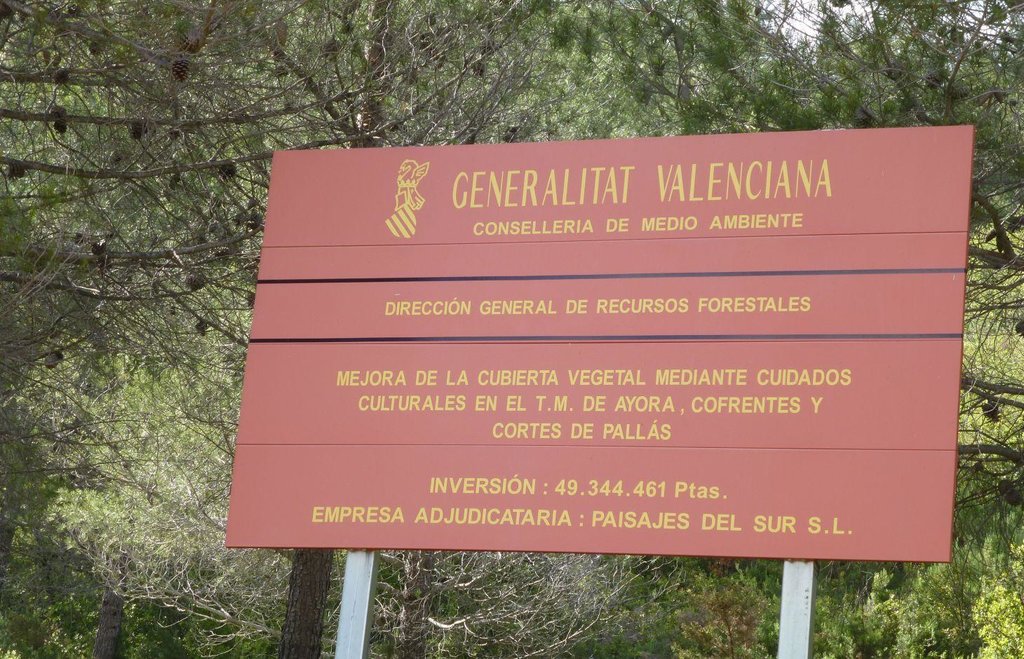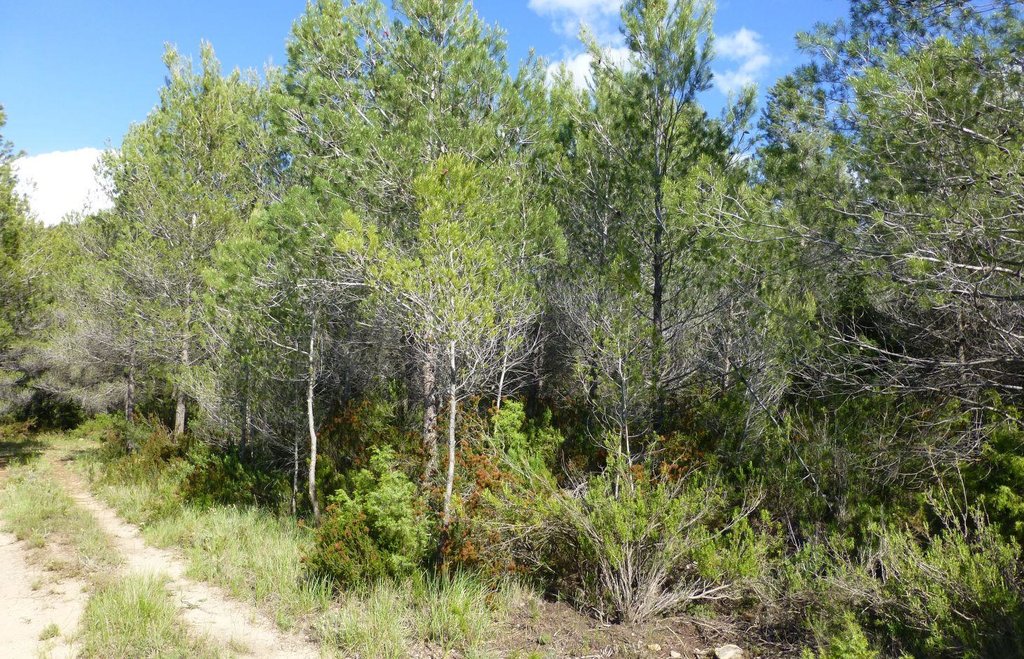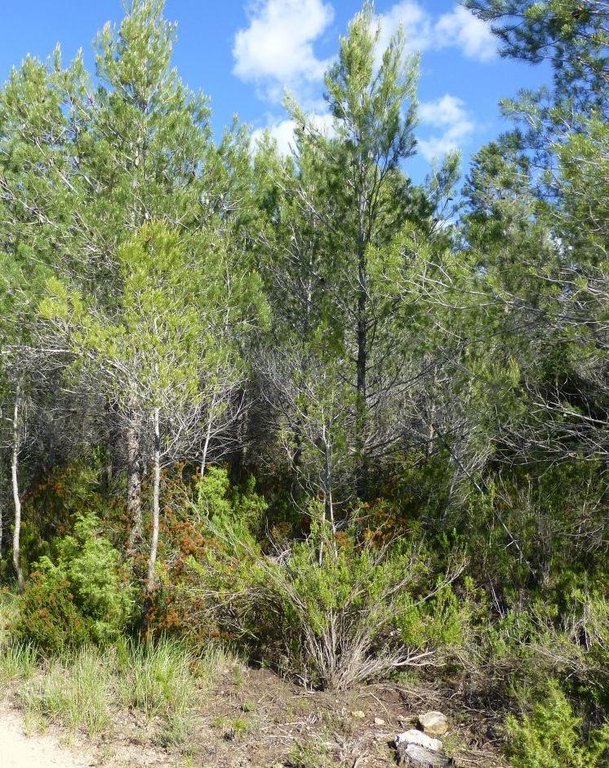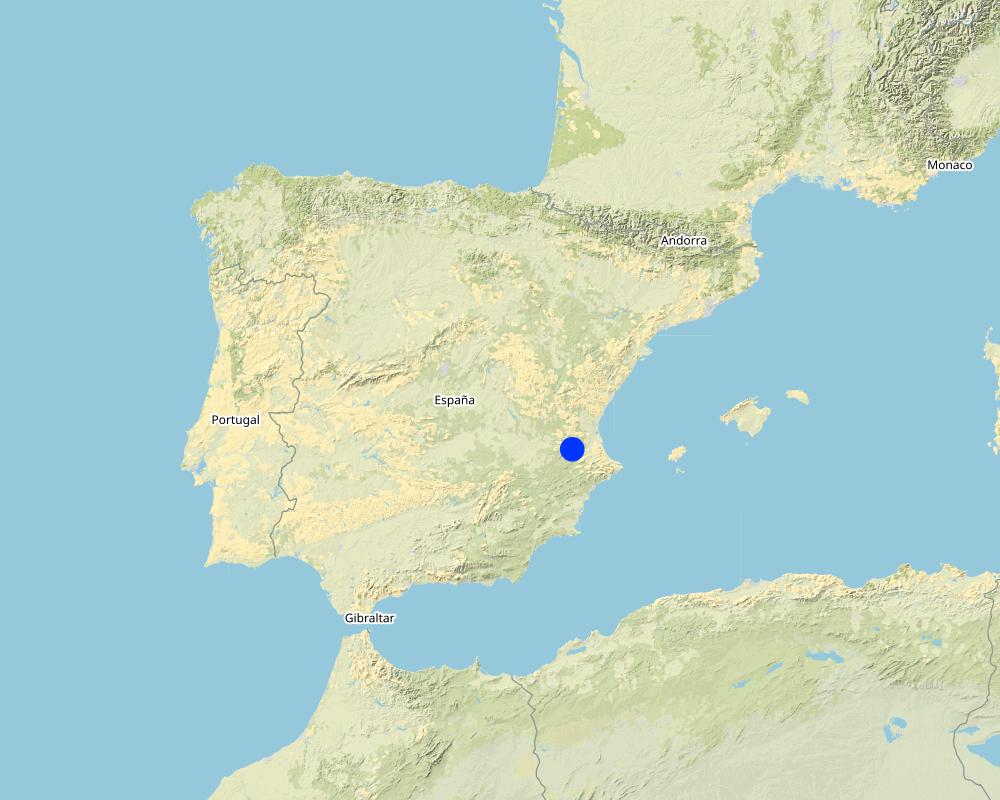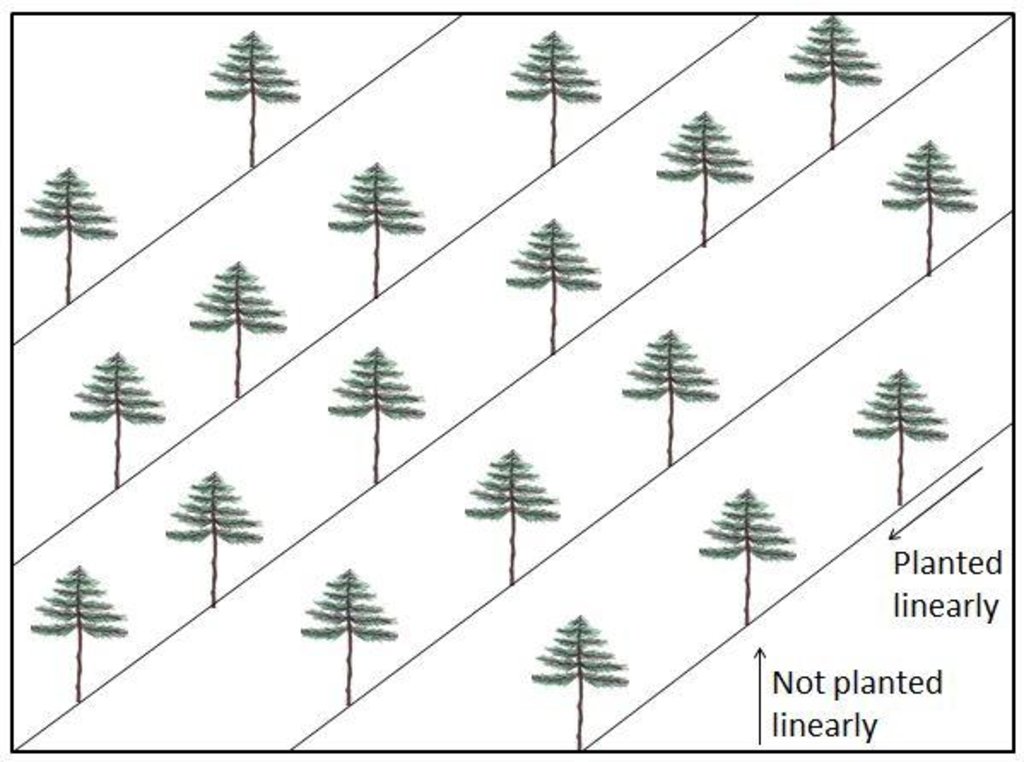Afforestation with Pinus Halepensis after the fire of 1979 (La Molinera) [Espagne]
- Création :
- Mise à jour :
- Compilateur : Nina Lauterburg
- Rédacteur : –
- Examinateurs : Alexandra Gavilano, Deborah Niggli, Hanspeter Liniger
Repoblación “La Molinera” con Pino Halepensis después del incendio del año 1979 (Spanish)
technologies_1584 - Espagne
Voir les sections
Développer tout Réduire tout1. Informations générales
1.2 Coordonnées des personnes-ressources et des institutions impliquées dans l'évaluation et la documentation de la Technologie
Spécialiste GDT:
Valdecantos Alejandro
Fundación Centro de Estudios Ambientales del Mediterráneo (CEAM)
Espagne
Spécialiste GDT:
Colomer Vicente
Forest Agent Generalitat Valenciana (Conselleria de infraestructura, territorio y medio ambiente)
Espagne
Nom du projet qui a facilité la documentation/ l'évaluation de la Technologie (si pertinent)
Catastrophic shifts in drylands (EU-CASCADE)Nom du ou des institutions qui ont facilité la documentation/ l'évaluation de la Technologie (si pertinent)
Centro de Estudios Ambientales del Mediterraneo (CEAM) - Espagne1.3 Conditions relatives à l'utilisation par WOCAT des données documentées
Le compilateur et la(les) personne(s) ressource(s) acceptent les conditions relatives à l'utilisation par WOCAT des données documentées:
Oui
1.4 Déclaration sur la durabilité de la Technologie décrite
Est-ce que la Technologie décrite ici pose problème par rapport à la dégradation des terres, de telle sorte qu'elle ne peut pas être déclarée comme étant une technologie de gestion durable des terres?
Non
2. Description de la Technologie de GDT
2.1 Courte description de la Technologie
Définition de la Technologie:
Post-fire afforestation with Pinus Halepensis to reduce soil erosion and to enhance forest growth.
2.2 Description détaillée de la Technologie
Description:
As a consequence of the devastating fire of the year 1979 which destroyed 33’000 ha of forest, strong erosion processes occurred on the bare soil and hindered the vegetation to regrow. Furthermore, this region was already abandoned (rural exodus) and missing management practices increased the problem of erosion. Therefore the government mandated to afforest the burnt areas in 1985.
The main purpose of the afforestation was to reduce the soil erosion (which was severe at that time) by planting trees, which increases soil stability and enables forest growth again. But the state also wanted to ensure wood extraction in the future. Furthermore, the visual impact was an important driver for afforesting this area.
The afforestation was executed in the winter of 1985 (November-February/March) by the regional forest services (Conselleria de agricultura). Forest engineers, who worked for the state and planned the project, collaborated with forest agents whereas the involved forest agents contracted local villagers to help afforesting these areas. The forest agent acted as a link between engineer and forest brigade and controlled if the brigade executed what the engineer proposed. He also provided assistance to the workers. The forest brigade was paid by day-if it was raining, people did not work and did not get any salary.
Nobody could provide direct information on the afforestation process in 1985 but there are not many differences of how they did it in the past and how it works today. The planting holes (60cm x 60cm x 60cm) were created with a machine (Caterpillar) using a “spoon” to open a hole and cover it again. This process loosens the soil (only possible in soils which are free from big stones). It should be noted that they did not use a ripper, they knew that the soil is destroyed using this technique. The seedlings were planted manually by the forest workers and arranged linearly because this facilitated the handling of the machines. Since the soil had a low stone content, it was suitable for the establishment of a forest.
The afforested area covered around 100 ha (not continuously). Today, the costs of an afforestation are around 1500 Euro per ha, but in the past it was less expensive. They only planted Pinus Halepensis. Today, a seedling of this tree species costs between 20 and 60 Cents. If the regional forest services have their own nurseries, they do not need to spend money to buy seedlings.
The success of an afforestation depends on numerous factors such as aspect and humidity (better on north-facing slopes), soil amount/fertility (better conditions on former cultivated fields), origin of the seedlings (adapted to the local climatic conditions), variability/uncertainty of the weather conditions (e.g. droughts, freezing). Usually a plantation is done in October/November and therefore especially the first summer determines the success. If it is too dry the plant will not grow (roots are too short to reach the humidity deeper in the ground). Further, the availability of trained people and the selection of appropriate machines are crucial.
The documented afforestation is one of a few examples of afforestation trials which succeeded. Today there is a forest where young pines are growing naturally ("children" of the planted ones), but also resprouter species (e.g. Quercus) can be found, which regenerated without having been planted and apparently were dispersed by birds.
But there are also some problems related to this afforestation. The forest agent explained that there is a high pest risk since monoplantations are less resilient to diseases (sick or dead plants in turn increase the fire risk). Another problem is that the trees were planted too densely (800-1000 plants per ha with a spacing of 5-10m) which requires recurrent management of the forest. Knowing about this problem, around the year 2003 they managed the area doing a selective clearing to reduce both the continuity and the competition between the species and thus also reduced the fire risk (“ayuda regeneración”). But the forest has become extremely dense again, thus increasing the risk of fires. There is a need to manage this area again and to extract biomass (selective clearing), but unfortunately no management project is planned for the near future.
The region of Ayora is mountainous with a dry subhumid climate (~380 mm annual rainfall). The risk of fire incidence is at its highest from June to September when there are adverse conditions like drought, high temperatures and strong winds (mainly the winds coming from central Spain, called “poniente”).
The population density is very low and there are only few job opportunities (e.g. marginal agriculture, grazing, hunting, beekeeping). The plantation provided jobs for rural people. Also today forest management could be a source for jobs.
2.3 Photos de la Technologie
2.5 Pays/ région/ lieux où la Technologie a été appliquée et qui sont couverts par cette évaluation
Pays:
Espagne
Région/ Etat/ Province:
Spain, Valencia
Autres spécifications du lieu:
Ayora, La Molinera
Spécifiez la diffusion de la Technologie:
- répartie uniformément sur une zone
S'il n'existe pas d'informations exactes sur la superficie, indiquez les limites approximatives de la zone couverte:
- 0,1-1 km2
Commentaires:
Boundary points of the Technology area: In the kmz file the whole afforestation of 1985/1986 is shown but it is not clear whether the whole area was afforested successfully. The coordinates indicated above show the location I visited which had success.
Map
×2.6 Date de mise en œuvre de la Technologie
Si l'année précise est inconnue, indiquez la date approximative: :
- il y a entre 10-50 ans
2.7 Introduction de la Technologie
Spécifiez comment la Technologie a été introduite: :
- par le biais de projets/ d'interventions extérieures
Commentaires (type de projet, etc.) :
The project was designed by the regional forest services of Valencia in 1985 (“Conselleria de agricultura” at that time, today it is called “Conselleria de infraestructura, territorio y medio ambiente”).
3. Classification de la Technologie de GDT
3.1 Principal(aux) objectif(s) de la Technologie
- réduire, prévenir, restaurer les terres dégradées
- préserver l'écosystème
3.2 Type(s) actuel(s) d'utilisation des terres, là où la Technologie est appliquée

Forêts/ bois
Type d’arbres:
- Espèces de Pinus (pin)
Produits et services:
- Bois d'œuvre (de construction)
- Fruits et noix
- Autres produits forestiers
- Conservation/ protection de la nature
- Protection contre les aléas naturels
- hunting
Commentaires:
Major land use problems (compiler’s opinion): The past land use resulted in a change of the vegetation composition (e.g. through removal of resprouter species). Due to rural exodus and land abandonment, the natural succession took place and fire-prone early-successional species colonized the abandoned fields. The vegetation grew without any control which seems to have caused the devastating fire of the year 1979 which destroyed 33’000 ha of forest. As a consequence of this fire, strong erosion processes occurred on the bare soil and hindered the vegetation to regrow. Furthermore, people which still lived there lost their properties after the fire and moved away as well. A consequence of the depopulation was a lack of management practices which increased the problem of post-fire erosion.
Number of growing seasons per year:
1
3.5 Groupe de GDT auquel appartient la Technologie
- gestion des plantations forestières
3.6 Mesures de GDT constituant la Technologie

pratiques végétales
- V1: Couverture d’arbres et d’arbustes
Commentaires:
Type of vegetative measures: aligned: -linear
3.7 Principaux types de dégradation des terres traités par la Technologie

érosion hydrique des sols
- Wt: perte de la couche superficielle des sols (couche arable)/ érosion de surface

dégradation biologique
- Bc: réduction de la couverture végétale
- Bf: effets néfastes des feux
Commentaires:
Main causes of degradation: deforestation / removal of natural vegetation (incl. forest fires) (Deforestation in the past (removal of resprouter species), land abandonment, uncontrolled growth of fire-prone vegetation, afforestations. The fire of 1979 destroyed 33'000 ha of forest.), population pressure (Vast areas were deforested in the past for agriculture, important key species were removed. After land abandonment there was a lack of management strategies), land tenure (After the fire, many people lost their properties and had to move away, therefore no management for post-fire erosion was applied.), labour availability (In the past there was outmigration from the region to the big cities and therefore there was a lack of management before and after the fire.), inputs and infrastructure: (roads, markets, distribution of water points, other, …) (The huge fire of 1979 could not be stopped easily because of the lack of fire extinction media like water ponds, streets, transport media (this has been improved now))
3.8 Prévention, réduction de la dégradation ou réhabilitation des terres dégradées
Spécifiez l'objectif de la Technologie au regard de la dégradation des terres:
- prévenir la dégradation des terres
- restaurer/ réhabiliter des terres sévèrement dégradées
4. Spécifications techniques, activités, intrants et coûts de mise en œuvre
4.1 Dessin technique de la Technologie
Spécifications techniques (associées au dessin technique):
The Pinus Halepensis seedlings were planted on a line in order to facilitate the operation of machines. The linear arrangement is still visible when observing the plantation from the distance, but when finding oneself within the forest this alignment is not visible anymore since the forest grew very densely. A part of today's forest grew naturally after planting the trees - some young pines but also some resprouters (e.g. Quercus) can be found which is pleasant and shows the success of this plantation effort. However, it would have been better to plant less trees with a bigger distance between the individuals.
To reduce the high density and continuity of the forest (and thus to reduce the fire risk) a selective clearing would be required but currently the state does not invest money in forest management practices. Without extraction of biomass this dense forest contains a high risk of fire.
Location: Ayora. Valencia, Spain
Date: 11-12-2013
Technical knowledge required for field staff / advisors: high (The forest agent needs a high technical knowledge. He acts as a link between engineer and forest brigade and controls if the brigade executes what the engineer dictates. He also provides assistance.)
Technical knowledge required for Engineer: high (The forest engineer works for the state and plans the project, therefore he needs a high technical knowledge)
Technical knowledge required for Forest brigade/workers: low (The forest workers only execute what the engineer and the forest agent tell them. They need to know how to handle the machines but don’t have to judge where to plant which species.)
Main technical functions: control of raindrop splash, control of dispersed runoff: retain / trap, control of dispersed runoff: impede / retard, control of concentrated runoff: retain / trap, control of concentrated runoff: impede / retard, improvement of ground cover, stabilisation of soil (eg by tree roots against land slides), sediment retention / trapping, sediment harvesting, increase of biomass (quantity)
Secondary technical functions: increase of surface roughness, increase in organic matter, increase in nutrient availability (supply, recycling,…), increase of infiltration, promotion of vegetation species and varieties (quality, eg palatable fodder)
Aligned: -linear
Vegetative material: T : trees / shrubs
Number of plants per (ha): 800-1000
Vertical interval within rows / strips / blocks (m): 5-10
Trees/ shrubs species: Pinus Halepensis
Auteur:
Nina Lauterburg
4.2 Informations générales sur le calcul des intrants et des coûts
autre/ monnaie nationale (précisez):
Euro
Indiquez le taux de change des USD en devise locale, le cas échéant (p.ex. 1 USD = 79.9 réal brésilien): 1 USD = :
0,74
Indiquez le coût salarial moyen de la main d'œuvre par jour:
47.00
4.3 Activités de mise en place/ d'établissement
| Activité | Calendrier des activités (saisonnier) | |
|---|---|---|
| 1. | Digging holes (60cm x 60cm x 60cm) | Once (1985), between November and February/March |
| 2. | Plantation of the seedlings (pinus halepensis) | Once (1985), between November and February/March |
4.4 Coûts et intrants nécessaires à la mise en place
| Spécifiez les intrants | Unité | Quantité | Coûts par unité | Coût total par intrant | % des coût supporté par les exploitants des terres | |
|---|---|---|---|---|---|---|
| Equipements | machine use | ha | 1,0 | 4857,0 | 4857,0 | |
| Coût total de mise en place de la Technologie | 4857,0 | |||||
| Coût total de mise en place de la Technologie en dollars américains (USD) | 6563,51 | |||||
Commentaires:
Duration of establishment phase: 4 month(s)
4.5 Activités d'entretien/ récurrentes
| Activité | Calendrier/ fréquence | |
|---|---|---|
| 1. | Selective clearing "ayuda regeneración" (only done once in 2003 but should be done again to decrease the risk of fires and competition between species) | late spring 2003 |
4.6 Coûts et intrants nécessaires aux activités d'entretien/ récurrentes (par an)
| Spécifiez les intrants | Unité | Quantité | Coûts par unité | Coût total par intrant | % des coût supporté par les exploitants des terres | |
|---|---|---|---|---|---|---|
| Equipements | machine use | ha | 1,0 | 2428,0 | 2428,0 | |
| Coût total d'entretien de la Technologie | 2428,0 | |||||
| Coût total d'entretien de la Technologie en dollars américains (USD) | 3281,08 | |||||
Commentaires:
The costs were calculated for the application of the technology on one hectare. Furthermore, the total costs of the afforestation were calculated with today’s costs because the costs at the time it was implemented are not known.
The currency rate (Euro-Dollar) was calculated on November 16th, 2013.
4.7 Facteurs les plus importants affectant les coûts
Décrivez les facteurs les plus importants affectant les coûts :
The costs of a plantation can be affected by numerous factors, such as slope (if the slope is steep, the work is much more difficult and takes more time, also because machines cannot be used on steep slopes), distance from a street (people can work less in a day if they have to walk far to plant), stone content of the soil (if there are many stones the work is much more difficult for the machines), soil type (plantations work much better on previous cropland because the soil is more fertile), origin of the seedlings (adapted to the local climatic conditions), variability/uncertainty of the weather conditions (e.g. droughts, freezing). If there are adverse climatic conditions or other negative circumstances the afforestation will not work well and this might cause higher costs.
5. Environnement naturel et humain
5.1 Climat
Précipitations annuelles
- < 250 mm
- 251-500 mm
- 501-750 mm
- 751-1000 mm
- 1001-1500 mm
- 1501-2000 mm
- 2001-3000 mm
- 3001-4000 mm
- > 4000 mm
Spécifications/ commentaires sur les précipitations:
Ayora: 383mm
Zone agro-climatique
- subhumide
Thermal climate class: temperate
5.2 Topographie
Pentes moyennes:
- plat (0-2 %)
- faible (3-5%)
- modéré (6-10%)
- onduleux (11-15%)
- vallonné (16-30%)
- raide (31-60%)
- très raide (>60%)
Reliefs:
- plateaux/ plaines
- crêtes
- flancs/ pentes de montagne
- flancs/ pentes de colline
- piémonts/ glacis (bas de pente)
- fonds de vallée/bas-fonds
Zones altitudinales:
- 0-100 m
- 101-500 m
- 501-1000 m
- 1001-1500 m
- 1501-2000 m
- 2001-2500 m
- 2501-3000 m
- 3001-4000 m
- > 4000 m
5.3 Sols
Profondeur moyenne du sol:
- très superficiel (0-20 cm)
- superficiel (21-50 cm)
- modérément profond (51-80 cm)
- profond (81-120 cm)
- très profond (>120 cm)
Texture du sol (de la couche arable):
- fin/ lourd (argile)
Matière organique de la couche arable:
- moyen (1-3%)
5.4 Disponibilité et qualité de l'eau
Profondeur estimée de l’eau dans le sol:
5-50 m
Disponibilité de l’eau de surface:
faible/ absente
Qualité de l’eau (non traitée):
eau potable
5.5 Biodiversité
Diversité des espèces:
- moyenne
5.6 Caractéristiques des exploitants des terres appliquant la Technologie
Orientation du système de production:
- exploitation mixte (de subsistance/ commerciale)
Individus ou groupes:
- employé (entreprise, gouvernement)
Genre:
- hommes
Indiquez toute autre caractéristique pertinente des exploitants des terres:
Land users applying the Technology are mainly common / average land users
Difference in the involvement of women and men: The work was mainly done by men, because it is heavy work and it is not usual that women are working in the forest.
Population density: < 10 persons/km2
Annual population growth: negative
5.8 Propriété foncière, droits d’utilisation des terres et de l'eau
Propriété foncière:
- état
- individu, avec titre de propriété
Droits d’utilisation des terres:
- individuel
- public/open access but organised (e.g. hunting)
- public/open access but organised (e.g. hunting)
Commentaires:
In the region, there is some public land, controlled by the state. But there is also some private land. The access to the public land is open but organized. Permission is needed from the government to cut trees, to build a house or to hunt. There are some private hunting areas for which the hunting association has to pay a fee.
6. Impacts et conclusions
6.1 Impacts sur site que la Technologie a montrés
Impacts socio-économiques
Production
production animale
Commentaires/ spécifiez:
After planting, grazing should be banned/restricted
production de bois
Commentaires/ spécifiez:
The natural process of vegetation growth was accelerated through the plantation of pines. There will be more wood in the future (develops only slowly).
diversité des produits
Commentaires/ spécifiez:
Wood, hunting, mushrooms
surface de production
Commentaires/ spécifiez:
Less agricultural land available (but the question is also if the land would be used for agriculture since it is quite a remote area)
production d'énergie
Impacts socioculturels
possibilités de loisirs
Commentaires/ spécifiez:
Forest has a higher aesthetic value than a burnt area or shrubland. In general people are attracted by afforestations, but since this afforestation has been done in a remote area people don’t visit this place more frequently
connaissances sur la GDT/ dégradation des terres
Commentaires/ spécifiez:
Local people know about the importance of conservation of the area and like to have a healthy forest which is protected from wildfires.
apaisement des conflits
situation des groupes socialement et économiquement désavantagés
Commentaires/ spécifiez:
The afforestation provided many job opportunities (in the year 1985, today not anymore)
contribution to human well-being
Commentaires/ spécifiez:
In the year 1985 the afforestation created jobs for the unemployed. But it seems that in general forest management is not something people want to do, they work in this sector only if there are no other job opportunities. Until today this attitude did not change much. Forest management means a hard job and this kind of work is not well-respected in society.
Impacts écologiques
Cycle de l'eau/ ruissellement
récolte/ collecte de l'eau
ruissellement de surface
drainage de l'excès d'eau
nappes phréatiques/ aquifères
évaporation
Commentaires/ spécifiez:
More moisture is stored in the soil and less water is lost by evaporation (the soil is covered)
Sols
humidité du sol
Commentaires/ spécifiez:
More soil moisture because of vegetation cover (soil is not exposed and does therefore not dry out)
couverture du sol
perte en sol
encroûtement/ battance du sol
cycle/ recharge des éléments nutritifs
matière organique du sol/ au dessous du sol C
Biodiversité: végétale, animale
biomasse/ au dessus du sol C
diversité végétale
Commentaires/ spécifiez:
Today different plant species can be found although only pines (Pinus Halepensis) was planted
diversité animale
Commentaires/ spécifiez:
There are maybe more animals because of shelter, different vegetation composition, and fodder supply. Hunters also cultivate some fields in this region to attract the game.
contrôle des animaux nuisibles/ maladies
Réduction des risques de catastrophe et des risques climatiques
risques d'incendies
Commentaires/ spécifiez:
Higher fire risk than if there would be agriculture or bare land. Lack of forest management resulted in a high density of the vegetation which increases the risk of fire
vitesse du vent
Commentaires/ spécifiez:
Trees reduce the wind velocity compared to shrubland or bare soil
6.2 Impacts hors site que la Technologie a montrés
inondations en aval
Commentaires/ spécifiez:
In general, but in this case it is not that important
dommages sur les champs voisins
Commentaires/ spécifiez:
In general but in this case it is not that important because in this area there are no cultivations
dommages sur les infrastructures publiques/ privées
Commentaires/ spécifiez:
Streets are better protected
Reduced amount of sediments in the water ponds for fire extinction
Commentaires/ spécifiez:
Less work is required to clean the water ponds
6.3 Exposition et sensibilité de la Technologie aux changements progressifs et aux évènements extrêmes/catastrophes liés au climat (telles que perçues par les exploitants des terres)
Changements climatiques progressifs
Changements climatiques progressifs
| Saison | Augmentation ou diminution | Comment la Technologie fait-elle face à cela? | |
|---|---|---|---|
| températures annuelles | augmente | bien |
Extrêmes climatiques (catastrophes)
Catastrophes météorologiques
| Comment la Technologie fait-elle face à cela? | |
|---|---|
| pluie torrentielle locale | bien |
| tempête de vent locale | pas connu |
Catastrophes climatiques
| Comment la Technologie fait-elle face à cela? | |
|---|---|
| sécheresse | pas bien |
Catastrophes hydrologiques
| Comment la Technologie fait-elle face à cela? | |
|---|---|
| inondation générale (rivière) | pas connu |
Autres conséquences liées au climat
Autres conséquences liées au climat
| Comment la Technologie fait-elle face à cela? | |
|---|---|
| réduction de la période de croissance | pas bien |
| fires | pas bien |
Commentaires:
The technology was not modified but it is important to add some notes to the above stated reactions to climatic extremes. If the temperature is decreasing to -15°C the pines are sensitive because they freeze. But they are tolerant against temperature increase always when there is water available (Pinus Hal. is more tolerant to temperature increase than Pinus Pinaster). Afforestations are more sensitive to droughts than natural forests because the afforested trees are not used to these hard conditions. If the pines are mature, they are more tolerant than young pines because their roots are longer and reach deeper into the ground. If there is a drought when pines are still young it can increase the risk of a fire. The pines are also sensitive to hail and snow.
6.4 Analyse coûts-bénéfices
Quels sont les bénéfices comparativement aux coûts de mise en place (du point de vue des exploitants des terres)?
Rentabilité à court terme:
négative
Rentabilité à long terme:
positive
Quels sont les bénéfices comparativement aux coûts d'entretien récurrents (du point de vue des exploitants des terres)?
Rentabilité à court terme:
neutre / équilibrée
Rentabilité à long terme:
neutre / équilibrée
Commentaires:
Short-term returns are negative because the management practice is expensive and until the trees reach a mature state, there are not many returns (in terms of wood and biomass). In the long-term this management practice shows a positive result because compared to bare soil or shrubland it has ecological benefits such as the reduction of soil erosion, and it also provides wood and biomass which could be extracted. Currently there is no management project because the state does not invest money but it would actually be required in order to maintain the healthy state of this forest patch and to control the fire risk. If there is money invested by the state they can do a selective clearing which will result in short-term returns, e.g. wood (but also in the long-term they will be able to extract wood).
6.5 Adoption de la Technologie
Commentaires:
There is no trend towards spontaneous adoption of the Technology
In Spain a lot of afforestation trials have been realized in the past but only a few of them succeeded.
6.7 Points forts/ avantages/ possibilités de la Technologie
| Points forts/ avantages/ possibilités du point de vue de l'exploitant des terres |
|---|
| There are also economic benefits for local people. The afforestation provided jobs for rural people. Furthermore, Pinus Halepensis seedlings grow faster and show a higher survival rate than other species, therefore the natural process of forest growth is increased which in turn results in the possibility to use the forest after some years again, e.g. extraction of wood/biomass for bioenergy or timber. But unfortunately this is not done frequently because it is expensive to clear the forest (located in a remote area). |
| Many stakeholders mentioned the positive visual impact. They prefer to have a forest instead of bare soil or shrubland, and it reminds them of how the state of the forest was before the fire. Trees have a higher value for them than shrubs. They supported the fact that the afforestation helped the environment to regenerate. |
| Compared to the situation after the fire there is a higher biodiversity due to the afforestation. |
| The afforestation contributed to rural development |
| Points forts/ avantages/ possibilités du point de vue du compilateur ou d'une autre personne ressource clé |
|---|
| The afforestation allowed the rehabilitation of an area affected by a devastating wildfire. It is an example out of many afforestation trials which succeeded. The success of this Pinus Halepensis afforestation is not only shown by the occurrence of healthy old pines, but also by the growth of young pines and resprouter species such as Quercus which were not planted. |
| Through the plantation of pines, the soil cover and stability was improved which in turn led to a decrease of soil erosion. The reduction in soil erosion (less transported sediments) also resulted in a decrease of damages of the infrastructure (such as streets or water ponds for fire extinction). |
6.8 Faiblesses/ inconvénients/ risques de la Technologie et moyens de les surmonter
| Faiblesses/ inconvénients/ risques du point de vue de l’exploitant des terres | Comment peuvent-ils être surmontés? |
|---|---|
| The area which was afforested is now not available anymore for agriculture. There is therefore a loss of agricultural land, but it is not sure either whether there would be a farmer using this land since it is located in a remote area. | Local hunters are cultivating cereals next to the forest to attract the animals. This is also important for the animals because without these fields, they would probably have to leave this area due to the scarce fodder supply |
| The area is now less accessible for hunters because of the density of the forest which allows animals to hide themselves | In the opinion of the villagers it would be important to promote the relationship between humans and nature and to find a balance between forest use and natural processes. The consciousness of the patrimonial value of the forest should also be promoted. |
| Some stakeholders criticized the linear planting. This is not like nature “would do it”. | |
| There are many stakeholder who said that it was an error to do so many afforestations with Pinus Halepensis because in many regions nature would have regenerated by itself. It would have been possible to save a lot of money. A plantation causes high costs. | |
| Due to the lack of management and because there is almost no use of the forest by the local population, there is a high amount of shrubs which increases the fire risk and hinders from walking through the forest |
| Faiblesses/ inconvénients/ risques du point de vue du compilateur ou d'une autre personne ressource clé | Comment peuvent-ils être surmontés? |
|---|---|
| It would be necessary to extract biomass from the forest to decrease the continuity of the trees and shrubs. Due to the lack of forest management (the management activities are expensive and labour-intensive) there is an increased risk of fires. | More investments in forest management such as selective forest clearings are required. Managing the forest would not only decrease the risk of fire and the competition between the species but also generate benefits such as timber or biomass for bioenergy production. Furthermore, jobs would be generated. In general, after afforestations, it would be required that people manage the forest. Nowadays, there is only limited use of the forest – in the past people lived of the land, but today this is not the case anymore. E.g. grazing is almost not existing anymore but in fact this would be really important for the reduction of the fire risk. |
| It is not fully clear whether Pinus Halepensis plantations are a useful tool for restoration and it is also questioned whether it is sustainable to plant only Pinus Halepensis. Monoplantations result in the simplification of the landscape and alterations of habitats. One of the reasons why they used this species is that planting pines is kind of a tradition: it was always used for economic purposes because in earlier times the wood had a higher value. Furthermore, Pinus Halepensis seedlings grow faster and show a higher survival rate than other species, and since the aim of the afforestations was to have forest again in a short period of time, this species seemed to be the most suitable. But often in Pinus Halepensis Monoplantations other species do not grow (which is not the case in the documented afforestation). | Research carried out on this topic showed that it would be good to increase the diversity (e.g. with carrasca, sabina, enebros, madroños), to combine the plantation of pines with the plantation of broad-leaved resprouting species (such as holm oak), in order to take advantage of both the fast-growth features of pines and the high resilience of oaks. This also provides higher diversity and landscape heterogeneity |
| Monoplantations are more vulnerable to perturbations such as forest fires or pests. If there is a high amount of one specific species the spread of a pest is facilitated. Sick or dead trees in turn increase the fire risk. | It would be good to increase the diversity (e.g. with carrasca, sabina, enebros, madroños), to combine the plantation of pines with the plantation of broad-leaved resprouting species (such as holm oak), in order to take advantage of both the fast-growth features of pines and the high resilience of oaks. |
| Additional information: The here documented afforestation was successful, but usually many plantations of Pinus Halepensis failed (low seedling survival rate) | Seedling survival can in some cases (has also be questioned) be enhanced through preconditioning, water harvesting techniques (micro-catchments), tree-shelters (protective tubes), fertilisation, application of mulch, using facilitating effects (planting close to a resource island or a nurse plant, to benefit from shade, change in soil properties, retention of soil and nutrients, protection from grazers), perch effect (providing bird perches e.g. dead trees, artificial woody structures, in old fields to accelerate colonisation rates (bird-mediated restoration)) |
7. Références et liens
7.1 Méthodes/ sources d'information
- visites de terrain, enquêtes sur le terrain
- interviews/entretiens avec les exploitants des terres
Quand les données ont-elles été compilées (sur le terrain)?
01/06/2013
7.2 Références des publications disponibles
Titre, auteur, année, ISBN:
Fernández-Ondoño, E., Rojo Serrano, L., Jiménez, M. N., Navarro, F. B., Díez, M., Martín, F., … Aguilar, J. (2010). Afforestation improves soil fertility in south-eastern Spain. European Journal of Forest Research, 129(4), 707–717.
Titre, auteur, année, ISBN:
Maestre, F. T., & Cortina, J. (2004). Are Pinus halepensis plantations useful as a restoration tool in semiarid Mediterranean areas? Forest Ecology and Management, 198(1-3), 303–317.
Titre, auteur, année, ISBN:
Pausas, J. G., Blad, C., Valdecantos, A., Seva, P., Fuentes, D., Alloza, A., … Estudios, C. De. (2004). Pines and oaks in the restoration of Mediterranean landscapes of Spain : New perspectives for an old practice – a review, (Vázquez 1998), 209–220.
Titre, auteur, année, ISBN:
Sánchez, J. R., Bonet, a., Bellot, J., & Chirino, E. (2006). Effects of 30-year-old Aleppo pine plantations on runoff, soil erosion, and plant diversity in a semi-arid landscape in south eastern Spain. Catena, 65(1), 19–29.
Titre, auteur, année, ISBN:
Valdecantos, a, Baeza, M. J., & Vallejo, V. R. (2009). Vegetation Management for Promoting Ecosystem Resilience in Fire-Prone Mediterranean Shrublands. Restoration Ecology, 17(3), 414–421.
Liens et modules
Développer tout Réduire toutLiens
Aucun lien
Modules
Aucun module trouvé


